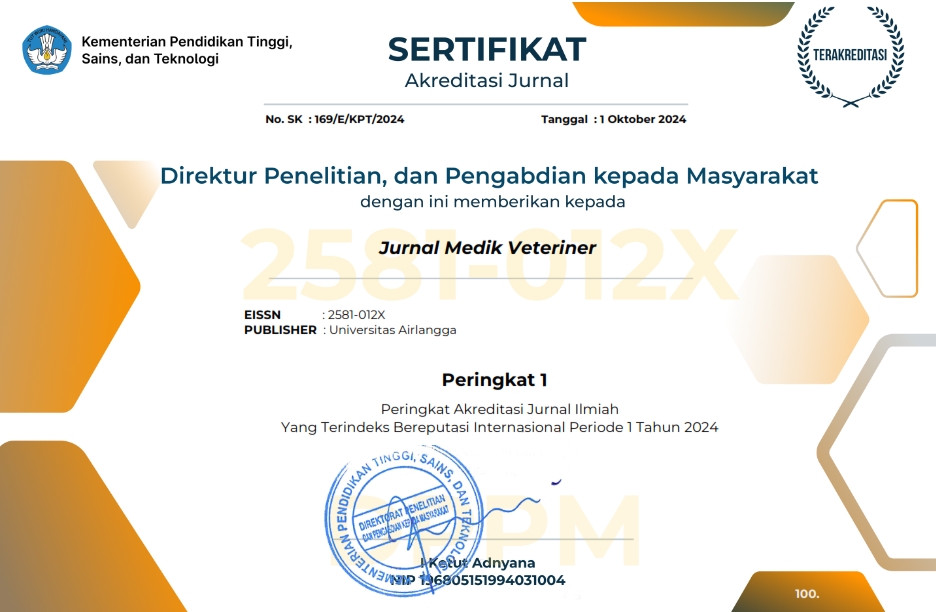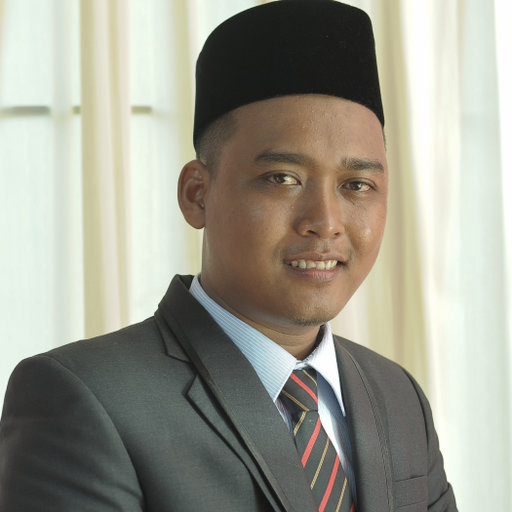Strongyloidiasis in Bornean Orangutan: A Case Report

Downloads
This study reported the diagnosis and treatment of Strongyloidiasis in two Bornean orangutans (Pongo pygmaeus); adult male aged 23 years, weighing 100 kg and an infant female orangutan, 4 years old, weighing 13,6 kg. Samples were physically and laboratory examined for faeces using the Mini-FLOTAC method. Therapy was performed on the adult orangutan using albendazole at a dose of 400 mg individual twice a day for 4 days, orally. The infant orangutan was administered albendazole at a dose of 10 mg/kg BW once a day for 3 days orally. From several physical examinations, both orangutans looked active, body temperature and oral mucosa color were normal, green feces with solid consistency in the adult orangutan and brown with solid consistency in the infant orangutan. Microscopic faeces examination of the adult orangutan showed Strongyloides sp. as many as 1005 eggs per gram (EPG) of feces, and the infant orangutan as many as 2490 larvae per gram of feces. Both orangutans were diagnosed with severe Strongyloidiasis based on those examinations. Three days after starting treatment, the adult orangutan's EPG decreased to 890, and a week later, no Strongyloides sp. eggs or larvae were discovered. A week following treatment, no Strongyloides sp. was discovered in an infant orangutan. In conclusion, albendazole was an effective treatment for severe Strongyloidiasis in adult and infant orangutans. Strongyloidiasis can be a threat to both infant and adult orangutans without distinct clinical symptoms.
Ancrenaz, M., Gumal, M., Marshall, A. J., Meijaard, E., Wich, S. A., & Husson, S. (2016). Pongo pygmaeus (errata version published in 2018). The IUCN red list of threatened species 2016: e.T17975A123809220. https://dx.doi.org/10.2305/IUCN.UK.2016-1.RLTS.T17975A17966347.en. Accessed on 4 May 2023.
CITES. (2023). Appendices I, II and III valid from 4 May 2023. https://cites.org/sites/default/files/eng/app/2023/E-Appendices-2023-05-04.pdf. Accessed on 5 May 2023.
Dalimunthe, N. P., Alikodra, H. S., Iskandar, E., & Atmoko, S. S. U. (2020). Manajemen pakan dan pemenuhan nutrisi orangutan Kalimantan (Pongo pygmaeus) di Taman Safari Indonesia dan Taman Margasatwa Ragunan. Jurnal Biologi Indonesia, 16(1), 57-66.
Daş, G., Klauser, S., Stehr, M., Tuchscherer, A., & Metges, C. C. (2020). Accuracy and precision of McMaster and Mini-FLOTAC egg counting techniques using egg-spiked faeces of chickens and two different flotation fluids. Veterinary Parasitology, 283, 109158.
Enejoh, O. S., & Suleiman, M. M. (2017). Anthelmintics and their application in veterinary medicine. Research Medical Engineering Science, 2, 118-126.
Harahap, A. M., & Gultom, E. S. (2017). Derajat infeksi parasit gastrointestinal pada orangutan Sumatera (Pongo abelii) dan orangutan Kalimantan (Pongo pygmaeus) di Taman Hewan Pematang Siantar Sumatera Utara. Jurnal Generasi Kampus, 10(2), 188-194.
Huffman, M. A., Nahallage, C. A. D., Hasegawa, H., Ekanayake, S., De Silva, L. G. D. D., & Athauda, I. R. K. (2013). Preliminary survey of the distribution of four potentially zoonotic parasite species among primates in Sri Lanka. Journal of the National Science Foundation of Sri Lanka, 41(4), 319-326.
Junardi, Rifanjani, S., & Anwari, M. S. (2019). Prediksi suhu tubuh orangutan (Pongo Pygmaeus Wurmbii) berdasarkan suhu feses di Stasiun Penelitian Cabang Panti Taman Nasional Gunung Palung. Jurnal Tengkawang, 9(2), 104-111.
Kleinschmidt, L. M., Kinney, M. E., & Hanley, C. S. (2018). Treatment of disseminated Strongyloides spp. infection in an infant Sumatran orangutan (Pongo abelii). Journal Medical Primatology, 00, 1-4.
Kurniawati, D. A., Suwanti, L. T., Lastuti, N. D. R., Koesdarto, S., Suprihati, E., Mufasirin, M., & Pratiwi, A. (2020). Identifikasi Molekuler Blastocystis sp. pada Monyet Ekor Panjang (Macaca fascicularis) di Taman Nasional Baluran, Situbondo, Jawa Timur. Jurnal Medik Veteriner, 3(2), 138–144.
MynáÅ™ová, A., Foitová, I., KváÄ, M., KvÄ›toňová, D., Rost, M., & Morrogh-Bernard, H. (2016). Prevalence of Cryptosporidium spp., Enterocytozoon bieneusi, Encephalitozoon spp. and Giardia intestinalis in wild, semi-wild and captive orangutans (Pongo abelii and Pongo pygmaeus) on Sumatra and Borneo, Indonesia. PLoS ONE, 11(3), e0152771.
Nosková, E., Modrí½, D., Baláž, V., ÄŒervená, B., Jirků-Pomajbíková, K., Zechmeisterová, K., Leowski, C., Petrželková, K. J., PÅ¡enková, I., VodiÄka, R., Kessler, S. E., Ngoubangoye, B., Setchell, J. M., & PafÄo, B. (2023). Identification of potentially zoonotic parasites in captive orangutans and semi-captive mandrills: Phylogeny and morphological comparison. American Journal of Primatology, 85, e23475.
Nurcahyo, W., & Prastowo, J. (2013). Strongyloides spp. distribution on orangutans in Tanjung Putting National Park, Care Center in Pangkalanbun, and Sebangau National Park. Jurnal Veteriner, 14(2), 255-261.
Nurcahyo, W., Konstanzová, V., & Foitová, I. (2017). Parasites of orangutans (primates: ponginae): An overview. American Journal of Primatology, 79(6), e22650.
Panda, A., Djohan, T. S., Artama, W. T., & Priyowidodo, D. (2021). Parasitic load and self-medication of Bornean orangutan (Pongo pygmaeus ssp.wurmbii) in Sebangau National Park Central Kalimantan Indonesia. IOP Conference Series: Earth Environment Science, 736, 012055.
Selian, R. M., Hanafian, M., & Erdiansyah, R. (2013). Identifikasi parasit gastrointestinal pada feses orangutan Sumatera (Pongo abelii) semi liar di kawasan Cagar Alam Pinus Jantho Kabupaten Aceh Besar, Jurnal Kedokteran Hewan, (1), 26-32.
Smith, J. (2020). Strongyloidiasis review and recommendations: a significant disease of orangutans. Veterinary Advisor, AZA's Orangutan SSP.
Supriadi, Fitria, W. A., & Nurcahyo, R. W. (2012). Balantidium sp. infection in faeces samples of orangutan (Pongo pygmaeus) from Care Center and Tanjung Puting National Park Area, Central Borneo. Biology, Medicine, & Natural Product Chemistry, 1(1), 47-52.
Suroiyah, F. A., Hastutiek, P., Yudhana, A., Sunarso, A., Purnama, M. T. E., & Praja, R. N. (2018). Prevalensi infeksi Toxocara cati pada kucing peliharaan di Kecamatan Banyuwangi. Jurnal Medik Veteriner, 1(3), 99-104.
Wich, S. A., Singleton, I., Nowak, M. G., Atmoko, S. S. U, Nisam, G., Arif, S. M., Putra, R. H., Ardi, R., Fredriksson, G., Usher, G., Gaveau, D. L. A., & Kühl, A. S. (2016). Land-cover changes predict steep declines for the Sumatran orangutan (Pongo abelii). Science Advances, 2(3), e1500789–e1500789.
Yahaya, Z. S., Dharmalingam, S. A., & Salleh, N. (2013). Prevalence and antelmintic efficacy studies on gastrointestinal parasites of semi captive orangutans at Orang-Utan Island (OUI), Bukit Merah, Perak. Journal of Oil Palm & The Environment, 4, 29-40.
Zulfikri, M., Ridwan, Y., & Cahyaningsih, U. (2018). Prevalence of intestinal helminth parasites in wild and soft-release Bornean orangutan (Pongo pygmaeus) in Lamandau Wildlife reserve, Central Kalimantan. IOP Conference Series: Material Science Engineering, 434, 012135.
Copyright (c) 2023 Putu Suandhika, Agatha Ria Susanti, Agnes Pratamiutami Sriningsih, Carlo Yunior Ray Hina, Yanuartono Yanuartono, Soedarmanto Indarjulianto, Dwi Priyowidodo

This work is licensed under a Creative Commons Attribution-NonCommercial-ShareAlike 4.0 International License.
Authors who publish in this journal agree to the following terms:
1. The journal allows the author to hold the copyright of the article without restrictions;
2. The journal allows the author(s) to retain publishing rights without restrictions;
3. The legal formal aspect of journal publication accessibility refers to Creative Commons Attribution-NonCommercial-ShareAlike 4.0 International License (CC BY-NC-SA).






11.jpg)




















